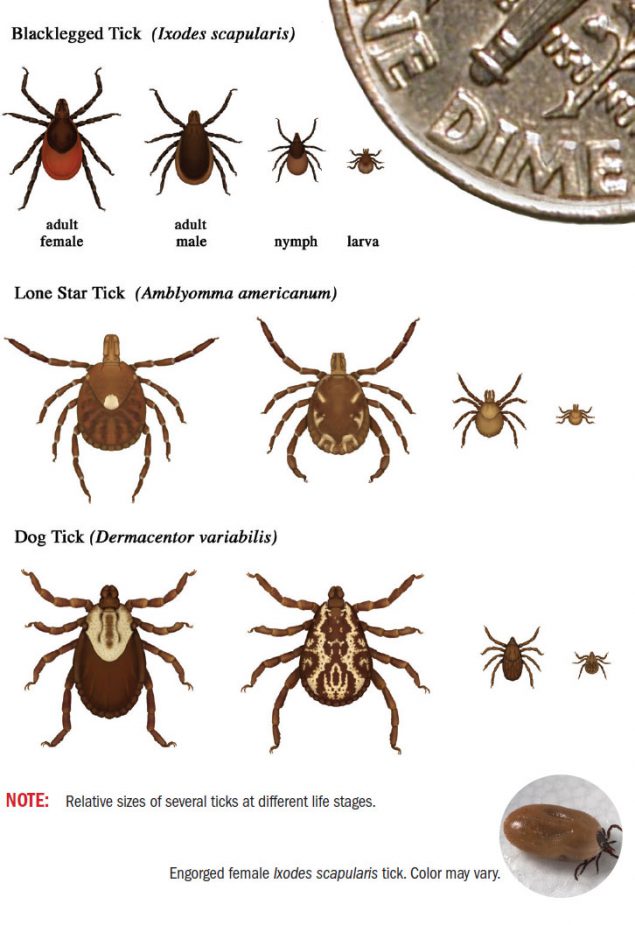FORT LEE, Va. –
Kenner Army Health Clinic is emphasizing tick awareness during this time of increased outdoor activities.
Ticks are active throughout the spring and summer months. Much like mosquitos, they feed on blood, whether it’s from animals or humans. Tick awareness and safeguards are necessary when not only venturing into the woods for camping, hiking or military training, but also when individuals are doing yardwork or enjoying leisurely outdoor activities in places where leaves and greenery are in abundance. Pets can even bring ticks into the home.

While there are ways to repel ticks, it’s nearly impossible to keep yourself, loved ones, pets, members of your unit, etc., entirely free of these blood-sucking insects. With that in mind, it’s a good idea to know what ticks look like, how to properly remove them if one attaches itself to your skin and what sort of illnesses you should be aware of if bitten.
The Lone Star, American Dog, Brown and Deer tick are the common types found in Virginia (images and descriptions available at
www.cdc.gov/ticks/tickbornediseases/tickID.html). Any of them can carry infectious diseases that they pass to their host through bacteria or viruses in their saliva.
According to the Centers for Disease Control and Prevention, some of the diseases found in ticks include Rocky Mountain Spotted Fever, Human Monocytic Ehlichiosis, Human Granulocytic Ehlichliosis, Lyme Disease, Southern Tick Associated Rash Illness, Babesiosis and Tularemia. Tick-borne diseases have many of the same symptoms – fevers and chills, aches and pains, and rashes around the bite location. Few cases result in death, especially if quickly diagnosed and treated.
Not all ticks are infected and there is no way to tell if they’re carrying a disease just by looking at them. Also keep in mind that these insects would need to attach themselves and feed on your blood for several hours before an infection is passed. Therefore, it is important to remove any tick that is attached to your skin as soon as possible and have it sent to be tested.
Ideally, seeking assistance from a medical professional to properly remove a tick is best. If that’s not an option, remember the following guidelines:
• Do not apply materials such as petroleum jelly, finger nail polish or remover, repellants, pesticides or a lighted match to the tick while it is attached. These materials are usually ineffective and could agitate the tick to the point that it salivates or regurgitates infected fluid into the wound site.
• Ticks are best removed with pointed tweezers or tick spoons. Grasp the tick’s mouthparts against the skin and pull slowly and steadily with firm force in the reverse of the direction in which the mouth parts are inserted. Do not squeeze, twist, jerk or crush the body of the tick because this may force infected body fluids through the mouthparts and into the wound site. Pulling slowly and steadily also will prevent the mouth parts from being torn from the body, leaving them embedded in the skin. The mouthparts alone cannot transmit disease but it’s best to remove all parts of the tick to prevent secondary infection.
• Following removal of the tick, wash the wound and your hands with soap and warm water, then apply an antiseptic. Place the tick in a sealable plastic bag and label it with your name, the date it was removed and the location where you may have encountered the insect. Place the bag in the freezer until you can bring it to your assigned health care provider.
At Kenner, the Environmental Health Services staff will mail the tick to the Army Public Health Center for testing. This process can take 3-to-5 weeks. If any specimen tests positive for any disease, the APHC will immediately notify Kenner and the beneficiary, in turn, will be contacted and encouraged to get with their assigned healthcare provider for further testing and/or treatment. Only persons with positive tick samples will be notified. Those with questions about the process may call the EHS staff at 804-734-9846.
There are several protective measures that will reduce the chances of being bitten by a tick. The first line of defense is clothing – shirts, pants, high-ankle socks and close-toed shoes or boots. In situations where a tick encounter would be more likely – doing lawn work, hiking or training in wooded areas, sleeping outdoors, etc. – tucking shirt tails into pants and pant legs into boots is recommended.
Use insect repellent containing DEET on your exposed skin and an insect repellent containing permethrin on your clothing. Check your clothing thoroughly for ticks before going inside, and check your whole body when indoors. Placing clothes in a hot dryer for 20-30 minutes is the best way to ensure any ticks you failed to notice are killed. If your pets go outdoors, groom them carefully for ticks every time you bring them back inside.
For more information and additional tips, visit
cdc.gov/ticks/index.html. A kids’ resource can be found at
www.cdc.gov/ticks/resources/DontletTicksbitemeComicGenericFS_508.pdf.